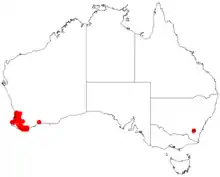Acacia incurva
Acacia incurva is a shrub belonging to the genus Acacia. It is native to the South West region of Western Australia.[1]
| Acacia incurva | |
|---|---|
| Scientific classification | |
| Kingdom: | Plantae |
| Clade: | Tracheophytes |
| Clade: | Angiosperms |
| Clade: | Eudicots |
| Clade: | Rosids |
| Order: | Fabales |
| Family: | Fabaceae |
| Clade: | Mimosoideae |
| Genus: | Acacia |
| Species: | A. incurva |
| Binomial name | |
| Acacia incurva | |
 | |
| Occurrence data from AVH | |
The shrub has a low, multi-stemmed, erect or prostrate and spinescent habit. It typically grows to a height of 0.2 to 0.5 metres (0.7 to 1.6 ft).[1] The stems are angled and the phyllodes are continuous with branchlets with the free portion of the phyllodes having a linear to linear-lanceolate shape with a length of 10 to 50 millimetres (0.4 to 2.0 in) and a width of 1 to 2 mm (0.04 to 0.08 in).[2] It blooms in the winter months between July and September producing spherical yellow inflorescences.[1] Each simple globular inflorescence has sessile heads and contains between six and eleven bright yellow flowers. Later it will form terete seed pods that are up to 7 centimetres (2.76 in) in length with a diameter of around 2 mm (0.08 in). Each pod is crustaceous, reddish in colour with longitudinale nerves.[2]
The species was first formally described by the botanist George Bentham in 1842 as part of William Jackson Hooker's work Notes on Mimoseae, with a synopsis of species in the London Journal of Botany. Synonyms for this species include; Racosperma incurvum, Acacia incurva var. brachyptera, Acacia incurva var. incurva and Acacia brachyptera.[3]
The species is found in swamps, winter-wet areas and clay flats where it grows in sandy, clay or lateritic soils.[1]
See also
References
- "Acacia incurva". FloraBase. Western Australian Government Department of Parks and Wildlife.
- "Acacia incurva". World Wide Wattle. Department of Parks and Wildlife. Retrieved 7 March 2018.
- "Acacia incurva Benth". Atlas of Living Australia. Global Biodiversity Information Facility. Retrieved 7 March 2018.